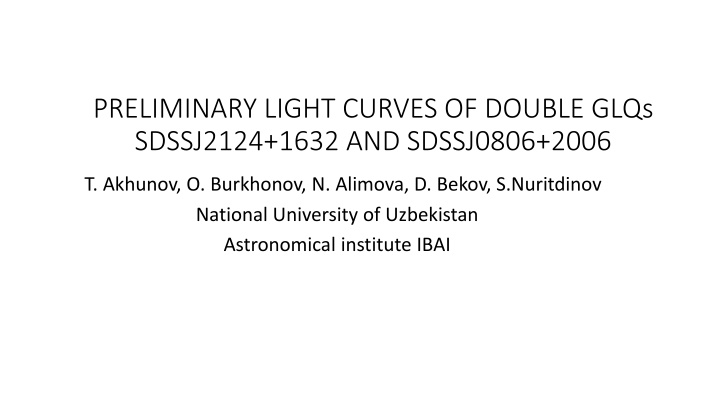
Light Curves of Double GLQs SDSSJ2124 and SDSSJ0806
Explore the preliminary light curves of double GLQs SDSSJ2124+1632 and SDSSJ0806+2006, discovered by Lemon et al. and N. Inada, respectively. Observations were conducted at the Maidanak Observatory using the AZT-22 telescope, revealing fascinating brightness variations in the lensed components A and B of these distant quasars. The findings hint at potential microlensing effects and internal variability within the source systems.
Download Presentation

Please find below an Image/Link to download the presentation.
The content on the website is provided AS IS for your information and personal use only. It may not be sold, licensed, or shared on other websites without obtaining consent from the author. If you encounter any issues during the download, it is possible that the publisher has removed the file from their server.
You are allowed to download the files provided on this website for personal or commercial use, subject to the condition that they are used lawfully. All files are the property of their respective owners.
The content on the website is provided AS IS for your information and personal use only. It may not be sold, licensed, or shared on other websites without obtaining consent from the author.
E N D
Presentation Transcript
PRELIMINARY LIGHT CURVES OF DOUBLE GLQs SDSSJ2124+1632 AND SDSSJ0806+2006 T. Akhunov, O. Burkhonov, N. Alimova, D. Bekov, S.Nuritdinov National University of Uzbekistan Astronomical institute IBAI
GLQ SDSSJ2124 + 1632 GLQ SDSSJ2124 + 1632 was discovered in 2017 by Lemon et al. This object consists of two components of a distant quasar. The angular separation between lensed images ~3.02" and source redshift Zq = 1.28. Observations of the object were carried out in the R-band at the Maidanak Observatory in 2018-2019 using 1.5 m telescope AZT-22. For photometry of lensed components, we used the DAOPHOT program. We have chosen the Moffat function to describe the light distribution in the images.
Lensed components of DSSJ0806+2006 On the right panel we can see the presence of enough bright lensing galaxy on the background of the B image. This fact led to scattering of photometric points in the light curve (see next slide)
The light curves of the reference star and the brightness variations of the system as whole (left) and lensed components A and B (right) are shown. It can be seen component A increases its brightness, repeating the behavior of the system as a whole. However, the amplitude of the variation is more than 2 times higher than the amplitude of the system and is equal to ~ 0.35 mag. At the same time, component B almost does not change its brightness. We see approximately the same behavior in the case of SDSSJ0806 + 2006. The system as a whole changes its brightness with an amplitude of ~ 0.2 mag, but the magnitude difference between the two components changes with time. This indicates the presence of not only internal variability of the source, but also possible long-period microlensing in both objects.
SDSSJ0806+2006 SDSSJ0806+2006 was discovered in 2006 by N. Inada. This object consists of two components of a distant quasar. The angular separation between them is 1.4" and source redshift is Zq = 1.54. Observations of these objects were carried out at the Maidanak Observatory in 2017-2019 in the 1.5 m telescope AZT-22, mainly in the R filter. For photometry of lensed components, we used the DAOPHOT program. We have chosen the Moffat function to describe the light distribution in the images.
The light curves of the reference star and the brightness variations of the system as whole (left) and lensed components A and B (right) are shown. It can be seen component A increases its brightness, repeating the behavior of the system as a whole with similar amplitude ~ 0.20 mag. The component B changes its brightness almost synchronously with componentA. The system as a whole changes its brightness with an amplitude of ~ 0.2 mag, but the magnitude difference between the two components do not changes over the time. This indicates, in opposite to the previous object, the absence the microlensing in this system. This situation resembles the situation in another lensed quasar UM 673.
